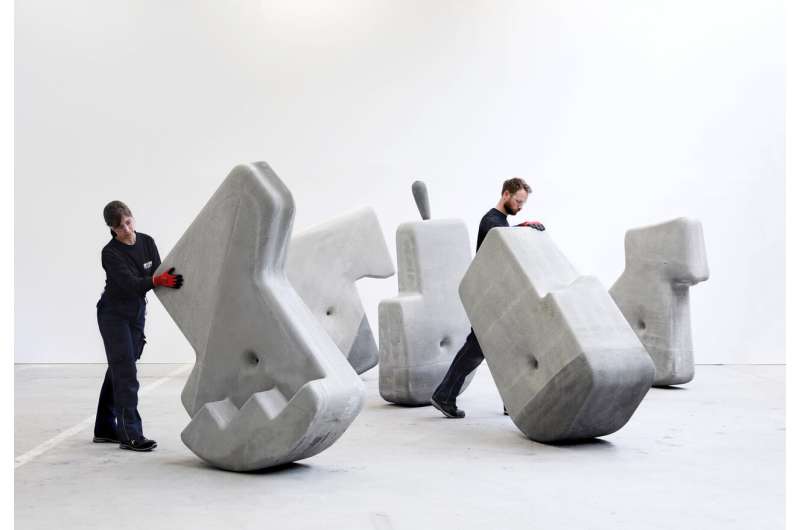April 19, 2019 weblog
Using the past to shape future construction: Slabs that rock, tilt and roll

If you are interested in hearing out novel concepts about the future of construction, a must-see video is "Walking Assembly." Dependencies on the sizes of materials vis a vis the human body do not seem to apply any longer.
The video shows two men guiding colossal concrete elements into place. No trucks. No cranes. This is not fake paper that has the look and feel of concrete. The effort was in collaboration with CEMEX Global R&D.
ArchDaily referred to "a crane-less tilt up construction method." In the video, concrete slabs are in giant puzzle shapes, and they roll around by the walkers, fit into place and balance on their own.
The two men are moving the large concrete forms and assembling them into multi-level platforms. Into walls. Into staircases. Make no mistake, though, as the video is more than titillating spectacle as performance art.
Cambridge, Massachusetts–based Matter Design, which is both a design practice and research lab, is focused on alternative ways of thinking, to reconsider our built environment.
Structures that would otherwise rely on cranes or heavy equipment are shown as assembled with little energy.
ArchDaily said "if a brick is designed for a single hand, and a concrete masonry unit (CMU) is designed for two, these massive masonry units (MMU) unshackle the dependency between size and the human body."
Business Insider discussed how they work. "To determine which building materials to use and where to place the center of mass, Matter Design relies on a computer algorithm. When the algorithm spots a formula that won't work in real life, the researchers can make adjustments to ensure the object will be mobile for humans."
Matter Design said, "By using variable density concrete, the center of mass of the object is calibrated precisely to control the stable, but easy motion of the elements. This ensures that these massive elements successfully walk and assemble into place."
Business Insider quoted Clifford who said "as we're designing the element, we can always ensure that the center of mass is pulled to where it needs to go."
To video viewers, these slabs are evocative of the ancient, of something very Stonehenge or Easter Island going on. And that is a reflection of Matter Design, "identifying ancient knowledge that holds resonance with topics of today."
Modern computer modeling and advanced fabrication technology put their concepts to work. According to Archinect, Brandon Clifford of the firm researches early methods of construction, translating them into a modern context and applying them to contemporary buildings and projects.
In this instance, "the architects were inspired by moai statues on easter island, which weigh up to 82 tons a piece and were reportedly moved by walking themselves," said designboom. Wait, what does that mean unless it is a bedtime story for children about rocks that could walk when nobody was looking?
The Architect's Newspaper would not leave you hanging.
"How did ancient peoples move the Moai of Easter Island? One theory is that these massive statues were designed to be 'walked,' or gradually rocked, into place. Walking Assembly, seeking to divorce the concept of masonry's scale from that of the humans placing it, returns to these preindustrial construction techniques." Jonathan Hilburg said, "Using rounded edges, handle points, and by pouring variable-density concrete to control each MMU's center of gravity, the components can be easily rocked, tilted, and rolled into place."
So, can Walking Assembly be a pointer to new directions for construction?
According to Business Insider, Clifford said the project could change the future of construction, (1) allowing companies to build without cranes and (2) possibly avoid demolishing structures. "While the typical commercial building is designed to last several decades, Matter Design's structures could last an eternity, Clifford said. They could also be taken apart to form new configurations."
More information: www.matterdesignstudio.com/#/walking-assembly/
© 2019 Science X Network




















